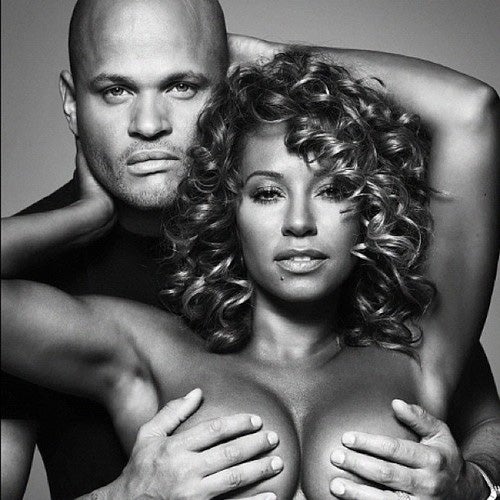The Independent's journalism is supported by our readers. When you purchase through links on our site, we may earn commission.
Why is breast cancer awareness made so sexy?
Cancer charities aren’t above employing the most depressingly sexist tactics just to publicise their cause.

Former Spice Girl Mel B has neatly embodied, or should I say embreasted, the growing trend of busty cancer awareness with the release of an ad campaign showing her aping Janet Jackson’s 1993 Rolling Stone cover where Mel appears topless with only her male partner’s hands covering her chest.
Apparently, “the sexy shot of Mel and her husband was taken to raise awareness of charity CoppaFeel! ahead of Breast Cancer Awareness month.” I’m not even sure quite where to start with pointing out everything that is cringeworthy about this statement, but let’s try the word ‘sexy’.
Breast cancer already is a ‘sexy’ disease, if you must, not just because it happens to involve women’s secondary sexual organs, but because it is one of the most well-publicised, well-funded of diseases that the human race is trying to be rid of. But cancer charities’ continuing compulsion to treat its audience like the guffawing viewers of a Carry-On film and patronise us with sexualised adverts is not just unnecessary, it’s offensive to us all.
We know breast cancer involves ‘boobies’. We’ve seen the cause endorsed by plenty of perky, dewy-skinned young women who still have both breasts intact. We’re aware of the connection to sex. And yes, this may have all helped increase our public awareness of the disease - it’s hard to imagine pancreatic cancer receiving the same attention, even though it has the lowest five year survival rate of all cancers suffered in the UK.
But having achieved such a strong presence in the public consciousness, breast cancer charities now need to use their position to stop insulting survivors – many of whom do not have both or even one breast to flash in airbrushed photo campaigns – and see that their advertising grows the hell up.
As writer Taslima Nasreen puts it, the focus on the sexualized ‘boobs’ as Mel B chummily describes them, “emphasizes an elevated status that a woman’s breast has over her person and ... reinforces importance that society places on these physical objects.” Appropriately, Taslima’s piece on the harm that breast cancer advertising does to its admirable objective is called “Did you ever think of sexualizing penile cancer, dude?”. And don’t even get me started on naming a campaign ‘Coppafeel’, with all its unpleasant overtones of surreptitious sexual assault that this implies.
Yet in an even more stunning move, in an attempt to publicise the certainly under-exposed fact that men can also suffer from breast cancer, women’s bodies have once again been hijacked to publicise a male cancer. In a viral video, Chris O Dowd (a comic I previously believed was classier than this, but for whom I have now lost all respect), plays the fictional Lars Larson, ‘health and safety officer for the ‘Topless Female Trampolining World Championship’.
Featuring young, slim, white women in various states of undress stretching, disrobing and bouncing on trampolines, the video lasts 4 minutes 44 minutes yet fails to actually mention men getting breast cancer till the viewer has endured 3 minutes 50 seconds of entirely gratuitous close-ups on female body parts. I thought we ceased to find bouncing bosoms an amusing and ‘ironic’ way of promoting a cause somewhere around the time we stopped finding Benny Hill funny.
But apparently no objectification is too cheap and tacky, as long as it’s only happening to women and as long as it’s being justified in the name of ‘a good cause’. This tactic is also deeply insulting to the male audience at which the campaign is aimed, as it assumes men are too stupid and simple-minded to take notice of an informative medical campaign unless it is couched in sexual imagery so obnoxious that even Peter Stringfellow would deem it ‘a bit sleazy’.
It’s time to put the boobs away and start behaving like adults. We know cancer kills, and most of us know we should be checking our breasts or chests or testicles or bowel movements for signs of these killers. Those of us who aren’t aware aren’t likely to become suddenly enlightened because someone shoves a pert pair of tits in their faces, and if they have proceeded unaware of cancer advertising for so long, they are probably more likely to be blinded by the sexualisation and fail to even notice the actual message of the campaign.
So how about a campaign called ‘Respect’, with clothed men and women of all ages, shapes and races, giving us some hard facts about the reality of all cancers and what we can do to prevent them. Because respect for their audience, both male and female, is entirely what’s lacking from both campaigns – and more offensive of all, respect for cancer survivors too.

Join our commenting forum
Join thought-provoking conversations, follow other Independent readers and see their replies